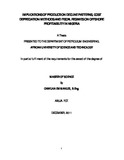| dc.contributor.author | Onwuka, Emmanuel | |
| dc.date.accessioned | 2016-10-25T09:43:07Z | |
| dc.date.available | 2016-10-25T09:43:07Z | |
| dc.date.issued | 2011-12-20 | |
| dc.identifier.uri | http://repository.aust.edu.ng/xmlui/handle/123456789/502 | |
| dc.identifier.uri | http://library.aust.edu.ng:8080/xmlui/handle/123456789/502 | |
| dc.description.abstract | Upstream petroleum industry remains one of the most prolific industries in terms of technology and risk capital transfer. Consequently, governments all over the world try to formulate political as well as economic structures that could favourably attract investments to their petroleum provinces.
These structures are spelt out in their petroleum fiscal systems. A good fiscal system tends to find a common ground for both government and the contractor by way of optimizing both efforts and benefits. Nigeria belongs to a region where hydrocarbon discovery risks are low compared to the world average. Therefore, the government designs fiscal regime that would seemingly extract more economic rent than normal from her petroleum resources. This research effort examined how to evaluate E & P business and determine the profitability of upstream business venture under the
proposed petroleum industry bill (PIB).
The methodology adopted a typical Niger-Delta offshore field with vast proved reserves, and applied the three Arps (exponential, hyperbolic and harmonic) decline equations during production. Based on each decline method, automated spreadsheet cash flow models were developed for 2005 PSC
and the proposed PIB 2009 fiscal systems. The cash flow had pre-production and operating costs expensed while depreciating the development costs by applying different depreciation methods.
The results showed that deepwater investment in Nigeria is profitable under both fiscal systems, given that the field production declines exponentially, irrespective of the depreciation method applied. It was also observed that contractor profit got maximized when Unit of Production (UOP) depreciation method was applied in the proposed PIB 2009 cash flow model while straight line depreciation (SLD) gave better profit measures for 2005 PSC, given that the terms of the fiscal systems remained constant. It was also confirmed that the proposed bill would give government greater share of the gross revenue.
As an incentive in the proposed PIB, it is recommended that the contractor be allowed to spread costs over time by applying unit of production depreciation method for cost recovery and tax calculation purposes. | en_US |
| dc.language.iso | en | en_US |
| dc.subject | Onwuka Emmanuel | en_US |
| dc.subject | Prof. Omowunmi Illedare | en_US |
| dc.subject | 2011 Petroleum Engineering Theses | en_US |
| dc.subject | Offshore | en_US |
| dc.subject | Production | en_US |
| dc.subject | Cost Depreciation Methods | en_US |
| dc.subject | Fiscal Regimes | en_US |
| dc.subject | Implications of Production Decline Patterns | en_US |
| dc.title | Implications of Production Decline Patterns, Cost Depreciation Methods and Fiscal Regimes on Offshore Profitability in Nigeria | en_US |
| dc.type | Thesis | en_US |

